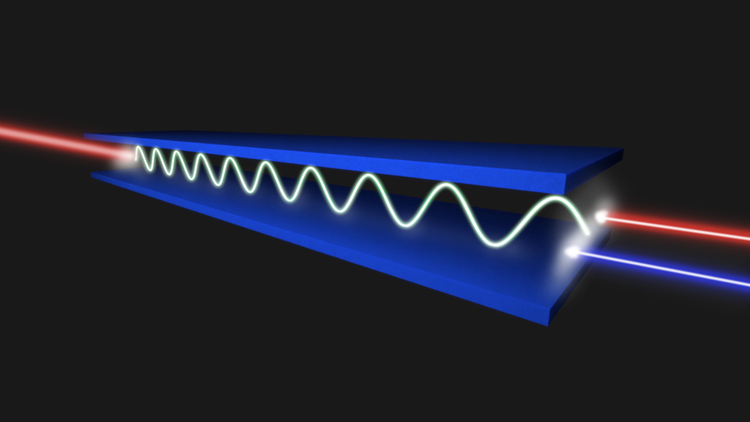A novel technique to successfully capture light and sound waves with the use of multilayer silicon nitride waveguides was developed by researchers from the University of Twente. The study efficiently demonstrated that manipulating light with sound in large-scale circuits is feasible and well-suited to existing production methods. Their study was published in the journal Science Advances.

3D illustration of the concept of trapping light and soundwaves in multilayer silicon nitride waveguides. Image Credit: University of Twente
Expanding the Photonic Toolbox
Electronic devices and chips have become exponentially faster and smaller in recent decades. Using light rather than electrons, researchers have almost reached the boundaries of “traditional” electronics and are currently exploring the transition between electronics and photonics. All types of new challenges emerge at this scale. For instance, the quantum effects or tiniest interferences could distort signals and render them unsuitable for use. At present, a study group from the University of Twente has included a fresh solution to the “photonic toolbox.”
Stimulated Brillouin Scattering—Manipulating Light With Sound
In the development of new quantum optics, sensors, and telecommunication techniques, the amplifying, filtering, and processing of optical signals are necessary. One method to perform this successfully is by employing a coherent optomechanical interaction technique known as stimulated Brillouin scattering.
In this technique, two finely tuned lasers produce a soundwave with frequencies that are one million times greater than the threshold of human hearing and capture it in a waveguide. The light passed through the waveguide communicates with the soundwave that will reflect a very tiny and particular part of the light spectrum, successfully filtering the signal.
Even though Brillouin scattering has been studied extensively in the last few years, it could never be implemented reliably on a chip suitable for use in our daily lives. Trapping the soundwave in a waveguide long enough to be effective, has proven to be very difficult. ‘Acoustic leakage’ is a big problem in traditional silicon-based platforms preventing strong Brillouin interactions. And alternative materials are often unstable, fragile, or even toxic.
Prof. David Marpaung, Professor, Nonlinear Nanophotonics Research Group, University of Twente
Breakthrough With Multilayer Silicon Nitride Waveguide
To confine both the acoustic and optical waves, the study group at the University of Twente has employed low-loss multilayer silicon nitride (Si3N4) nanophotonic circuits. Such circuits are comprised of 50 cm-long spiral waveguides. This setup captures the soundwave and avoids the acoustic leakage that happens while using a single silicon nitride core.
In addition to prospective outcomes in their experimental setup, the scientists created a working proof of concept and other feasible applications.
We demonstrated an RF cancellation notch filter, and the results show great potential for future stimulated Brillouin scattering on a silicon nitride chip.
Roel Botter, Study First Author, University of Twente
Marpaung states, “Our research makes integration of stimulated Brillouin scattering in large circuits possible. These new chips can be integrated with other emerging technologies such as tunable lasers, frequency combs, and programmable photonic circuits, potentially giving them a part in the future development of fields ranging from telecommunications to quantum computing.”
Collaborations and Funding
This research is the outcome of a four-year study on the practicality of stimulated Brillouin scattering in silicon nitride photonic circuits. The study was conducted at the MESA+ institute at the University of Twente in association with Dr. Yang Liu, a Scientist at the Laboratory of Photonics and Quantum Measurements at EPFL in Switzerland. The silicon nitride chips are generated by LioniX International, a spin-off of the University of Twente and an essential partner in the process of research.
Vidi and START UP programs of the Dutch Research Council (NWO), which supports advanced research projects with high scientific and societal impact, funded this study.
Journal Reference
Botter, R., et al. (2022) Guided-acoustic stimulated Brillouin scattering in silicon nitride photonic circuits. Science Advances. doi.org/10.1126/sciadv.abq2196.